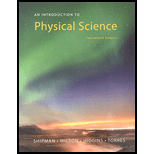
(a)
The compound
N 2 H 4
(a)
Answer to Problem 27E
Explanation of Solution
Given Info: The compound is
Explanation:
A covalent bond is formed when electron pairs are shared by two atoms. A covalent bond is formed when two nonmetals combine or compounds that are gases, liquids or have low melting points.
Ionic bonds are formed by electrostatic interactions between an electropositive and electronegative atom. An ionic bond forms when a metal and a nonmetal combine or a metal combines with polyatomic anions.
In the compound
Conclusion:
Therefore, the compound
(b)
The compound
NaF
(b)
Answer to Problem 27E
Explanation of Solution
Given Info: The compound is
Explanation:
A covalent bond is formed when electron pairs are shared by two atoms. A covalent bond is formed when two nonmetals combine or compounds that are gases, liquids or have low melting points.
Ionic bonds are formed by electrostatic interactions between an electropositive and electronegative atom. An ionic bond forms when a metal and a nonmetal combine or a metal combines with polyatomic anions.
In the compound
Conclusion:
Therefore,
(c)
The compound
Ca ( NO 3 ) 2
(c)
Answer to Problem 27E
Explanation of Solution
Given Info: The compound is
Explanation:
A covalent bond is formed when electron pairs are shared by two atoms. A covalent bond is formed when two nonmetals combine or compounds that are gases, liquids or have low melting points.
Ionic bonds are formed by electrostatic interactions between an electropositive and electronegative atom. An ionic bond forms when a metal and a nonmetal combine or a metal combines with polyatomic anions.
In the compound
Conclusion:
Therefore,
(d)
The compound
CBr 4
(d)
Answer to Problem 27E
Explanation of Solution
Given Info: The compound is
Explanation:
A covalent bond is formed when electron pairs are shared by two atoms. A covalent bond is formed when two nonmetals combine or compounds that are gases, liquids or have low melting points.
Ionic bonds are formed by electrostatic interactions between an electropositive and electronegative atom. An ionic bond forms when a metal and a nonmetal combine or a metal combines with polyatomic anions.
In the compound
Conclusion:
Therefore,
(e)
The compound
C 12 H 22 O 11
(e)
Answer to Problem 27E
Explanation of Solution
Given Info: The compound is
Explanation:
A covalent bond is formed when electron pairs are shared by two atoms. A covalent bond is formed when two nonmetals combine or compounds that are gases, liquids or have low melting points.
Ionic bonds are formed by electrostatic interactions between an electropositive and electronegative atom. An ionic bond forms when a metal and a nonmetal combine or a metal combines with polyatomic anions.
In the compound
Conclusion:
Therefore,
(f)
The compound
( NH 4 ) 3 PO 4
(f)
Answer to Problem 27E
Explanation of Solution
Given Info: The compound is
Explanation:
A covalent bond is formed when electron pairs are shared by two atoms. A stable covalent molecule is formed only when the octet rule is followed for the atoms which share electron pairs. A covalent bond is formed when two nonmetals combine or compounds that are gases, liquids or have low melting points.
Ionic bonds are formed by electrostatic interactions between an electropositive and electronegative atom. An ionic bond forms when a metal and a nonmetal combine or a metal combines with polyatomic anions.
In the compound
Conclusion:
Therefore,
Want to see more full solutions like this?
Chapter 12 Solutions
Bundle: An Introduction to Physical Science, 14th Loose-leaf Version + WebAssign Printed Access Card, Single Term. Shipman/Wilson/Higgins/Torres
- 20. Two small conducting spheres are placed on top of insulating pads. The 3.7 × 10-10 C sphere is fixed whie the 3.0 × 107 C sphere, initially at rest, is free to move. The mass of each sphere is 0.09 kg. If the spheres are initially 0.10 m apart, how fast will the sphere be moving when they are 1.5 m apart?arrow_forwardpls help on allarrow_forwardpls help on thesearrow_forward
- pls help on all asked questions kindlyarrow_forwardpls help on all asked questions kindlyarrow_forward19. Mount Everest, Earth's highest mountain above sea level, has a peak of 8849 m above sea level. Assume that sea level defines the height of Earth's surface. (re = 6.38 × 106 m, ME = 5.98 × 1024 kg, G = 6.67 × 10 -11 Nm²/kg²) a. Calculate the strength of Earth's gravitational field at a point at the peak of Mount Everest. b. What is the ratio of the strength of Earth's gravitational field at a point 644416m below the surface of the Earth to a point at the top of Mount Everest? C. A tourist watching the sunrise on top of Mount Everest observes a satellite orbiting Earth at an altitude 3580 km above his position. Determine the speed of the satellite.arrow_forward
- pls help on allarrow_forwardpls help on allarrow_forward6. As the distance between two charges decreases, the magnitude of the electric potential energy of the two-charge system: a) Always increases b) Always decreases c) Increases if the charges have the same sign, decreases if they have the opposite signs d) Increases if the charges have the opposite sign, decreases if they have the same sign 7. To analyze the motion of an elastic collision between two charged particles we use conservation of & a) Energy, Velocity b) Momentum, Force c) Mass, Momentum d) Energy, Momentum e) Kinetic Energy, Potential Energyarrow_forward
 An Introduction to Physical SciencePhysicsISBN:9781305079137Author:James Shipman, Jerry D. Wilson, Charles A. Higgins, Omar TorresPublisher:Cengage Learning
An Introduction to Physical SciencePhysicsISBN:9781305079137Author:James Shipman, Jerry D. Wilson, Charles A. Higgins, Omar TorresPublisher:Cengage Learning Modern PhysicsPhysicsISBN:9781111794378Author:Raymond A. Serway, Clement J. Moses, Curt A. MoyerPublisher:Cengage Learning
Modern PhysicsPhysicsISBN:9781111794378Author:Raymond A. Serway, Clement J. Moses, Curt A. MoyerPublisher:Cengage Learning University Physics Volume 3PhysicsISBN:9781938168185Author:William Moebs, Jeff SannyPublisher:OpenStax
University Physics Volume 3PhysicsISBN:9781938168185Author:William Moebs, Jeff SannyPublisher:OpenStax



